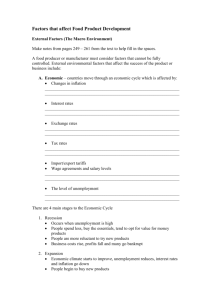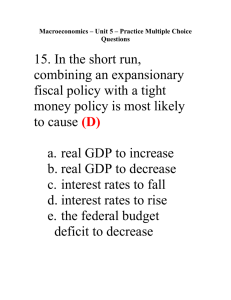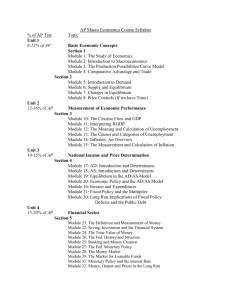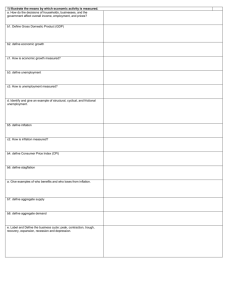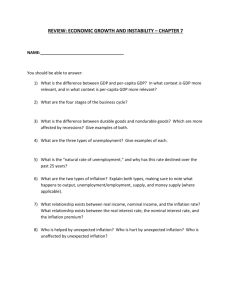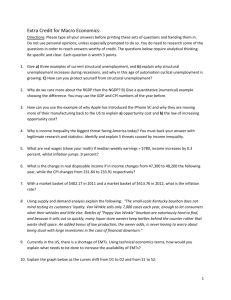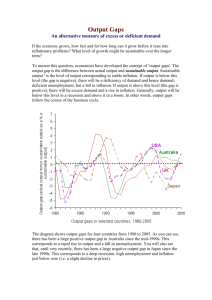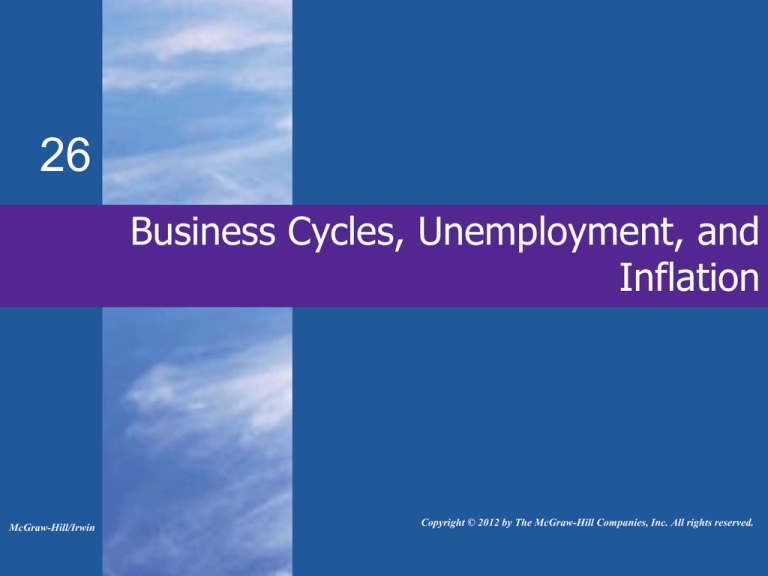
26
Business Cycles, Unemployment, and
Inflation
McGraw-Hill/Irwin
Copyright © 2012 by The McGraw-Hill Companies, Inc. All rights reserved.
The Business Cycle
• Alternating increases and decreases
•
LO1
in economic activity over time
Phases of the business cycle
• Peak
• Recession
• Trough
• Expansion
26-2
The Business Cycle
Peak
Level of real output
Peak
Peak
Trough
Trough
Time
LO1
26-3
The Business Cycle
U.S. Recessions since 1950
Period
Duration,
Months
Depth
(Decline in Real
Output)
1953-54
10
-2.6%
1957-58
8
-3.7
1960-61
10
-1.1
1969-70
11
-0.2
1973-75
16
-3.2
1980
6
-2.2
1981-82
16
-2.9
1990-91
8
-1.4
2001
8
-0.4
2007-09
18
-3.7
Source: National Bureau of Economic Research, http://www.nber.org and Minneapolis Federal Reserve
Bank, http://www.minneapolisfed.org Output data are in 2000 dollars
LO1
26-4
Causation: A First Glance
• Business cycle fluctuations
• Economic shocks
• Prices are “sticky” downwards
• Economic response entails
decreases in output and
employment
LO1
26-5
Causation: A First Glance
• Causes of shocks
• Irregular innovation
• Productivity changes
• Monetary factors
• Political events
• Financial instability
• Recession of 2007
LO1
26-6
Cyclical Impact
• Durable goods affected most
• Capital goods
• Consumer durables
• Nondurable consumer goods affected
less
• Services
• Food and clothing
LO1
26-7
Unemployment
Total
population
(307.3
million)
Under 16
and/or
Institutionalized
(71.4 million)
Unemployment rate =
# of unemployed
X 100
labor force
Not in
labor
force
(81.7 million)
Unemployment rate =
Employed
(139.9 million)
14,265,000
X 100 = 9.3%
154,142,000
Labor
force
(154.2
million)
Unemployed
(14.3 million)
LO2
26-8
Unemployment
• Criticisms of unemployment
• Involuntary part-time workers
counted as if full-time
• Discouraged workers are not
counted as unemployed
LO2
26-9
Types of Unemployment
• Frictional unemployment
• Individuals searching for jobs or
•
•
LO3
waiting to take jobs soon
Structural unemployment
• Occurs due to changes in the
structure of the demand for labor
Cyclical unemployment
• Caused by the recession phase of
the business cycle
26-10
Definition of Full Employment
• Natural Rate of Unemployment (NRU)
• Full employment level of
unemployment
• Can vary over time
• Demographic changes
• Changing job search methods
• Public policy changes
• Actual unemployment can be above
or fall below the NRU
LO3
26-11
Economic Cost of Unemployment
• GDP Gap
• GDP gap = actual GDP – potential
•
LO3
GDP
• Can be negative or positive
Okun’s Law
• Every 1% of cyclical unemployment
creates a 2% GDP gap
26-12
Economic Cost of Unemployment
Economic Cost of Unemployment
LO3
26-13
Economic Cost of Unemployment
LO3
26-14
Unequal Burdens
• Occupation
• Age
• Race and ethnicity
• Gender
• Education
• Duration
LO3
26-15
Unequal Burdens
Unemployment Rates by Demographic Group: Full Employment Year (2007) and Recession Year (2009)*
Unemployment Rate
Demographic Group
Overall
Occupation:
Managerial and professional
Construction and extraction
Age:
16-19
African American, 16-19
White, 16-19
Male, 20+
Female, 20+
Race and ethnicity:
African American
Hispanic
White
Gender:
Women
Men
**
Education:
Less than high school diploma
High school diploma only
College degree or more
Duration:
15 or more weeks
LO3
2007
2009
4.6%
9.3%
2.1
4.6
7.6
19.7
15.7
24.3
29.4
39.5
13.9
21.8
4.1
9.6
4.0
7.5
8.3
14.8
5.6
12.1
4.1
8.5
4.5
8.1
4.7
10.3
7.1
14.6
4.4
9.7
2.0
4.6
1.5
4.7
26-16
Noneconomic Costs
• Loss of skills and loss of self-respect
• Plummeting morale
• Family disintegration
• Poverty and reduced hope
• Heightened racial and ethnic tensions
• Suicide, homicide, fatal heart attacks,
•
LO3
mental illness
Can lead to violent social and political
change
26-17
Global Perspective
LO3
26-18
Inflation
• General rise in the price level
• Inflation reduces the “purchasing
•
power” of money
Consumer Price Index (CPI)
CPI =
CPI =
LO2
Price of the Most Recent Market
Basket in the Particular Year
Price estimate of the Market
Basket in 1982-1984
207.3
-
201.6
x
100
x
100 = 2.8%
201.6
26-19
Inflation
Inflation Rates in Five Industrial Nations
LO2
26-20
Inflation
LO2
26-21
Types of Inflation
• Demand-Pull inflation
• Excess spending relative to output
• Central bank issues too much
•
LO3
money
Cost-Push inflation
• Due to a rise in per-unit input costs
• Supply shocks
26-22
Inflation
• Difficult to distinguish inflation types
• Types differ in sustainability
• Demand-pull continues as long as
•
LO3
the excess spending continues
• Cost-push ends in a recession
Core inflation
• Without food and energy goods
• Focuses on more stable prices
26-23
Redistribution Effects of Inflation
• Nominal income
• Unadjusted for inflation
• Real income
• Nominal income adjusted for
•
inflation
Anticipated vs. unanticipated income
Percentage
change in
real income
LO3
=
Percentage
change in
nominal income
Percentage
change in
price level
26-24
Who is Hurt by Inflation?
• Fixed-income receivers
• Real incomes fall
• Savers
• Value of accumulated savings
•
LO3
deteriorates
Creditors
• Lenders get paid back in “cheaper
dollars”
26-25
Who is Unaffected by Inflation?
• Flexible-income receivers
• COLAs
• Social Security recipients
• Union members
• Debtors
• Pay back the loan with “cheaper
dollars”
LO3
26-26
Anticipated Inflation
• Real interest rate
• Rates adjusted for inflation
• Nominal interest rate
• Rates not adjusted for inflation
LO3
26-27
Anticipated Inflation
6%
11%
=
+
5%
Nominal
Interest
Rate
LO3
Inflation
Premium
Real
Interest
Rate
26-28
Other Redistribution Issues
• Deflation
• Mixed effects
• Incomes may rise
• Fixed assets values may fall
• For fixed-rate mortgages, real debt
•
LO3
declines
Arbitrariness
26-29
Does Inflation Affect Output?
• Cost-Push inflation
• Reduces real output
• Redistributes a decreased level of
•
LO3
real income
Demand-Pull inflation
• One view is that zero inflation is
best
• Another view is that mild inflation is
best
26-30
Hyperinflation
• Extraordinarily rapid inflation
• Devastates an economy
• Businesses don’t know what to charge
• Consumers don’t know what to pay
• Money becomes worthless
• Zimbabwe’s 14.9 billion percent
inflation in 2008
LO3
26-31
The Stock Market and the Economy
• Stock prices changing
• Wealth effect
• Investment effect
• Typical changes lead to weak effects
• Stock market bubbles
• Huge unwarranted rises in stock prices
• Excessive optimism and frenzied buying
• Can be detrimental to an economy
26-32

